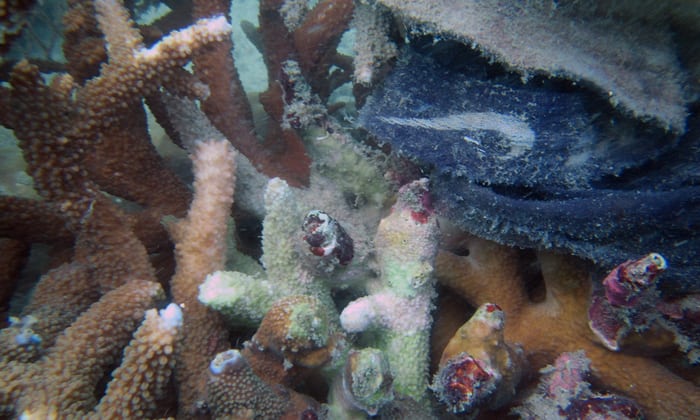A major new study estimates billions of pieces of plastic pollution are snagged on coral reefs, sending disease rates soaring. The discovery compounds the damage being done to a vital habitat that already faces an existential threat from the warming caused by climate change.
Around 11bn pieces of plastic contaminate vital reefs and result in infections: ‘It’s like getting gangrene,’ scientists warn. Scientists examined 125,000 corals across the Asia-Pacific region, home to half the world’s reefs, and found 89% of those fouled by plastic were suffering disease. On plastic-free reefs, only 4% of the corals were diseased.
The research is extremely significant because it is the first to examine the impact of plastic on disease in any marine organism and also the first to produce a large-scale estimate of how much plastic pollutes the sea floor.
The scientists who conducted the new analysis did not set out to research plastic but were confronted by it across the regions they surveyed. The correlation between plastic pollution and high rates of disease was very striking and the researchers think sharp plastic fragments cut the coral organisms, whilst plastic fabrics smother them and block out light and oxygen.
“Corals are animals just like me and you – they become wounded and then infected,” said Joleah Lamb, at Cornell University in the US, who led the new research, published in the journal Science. “Plastics are ideal vessels for microorganisms, with pits and pores, so it’s like cutting yourself with a really dirty knife.”
The international group of scientists examined corals spread across 159 reefs off the coasts of Indonesia, Thailand, Myanmar and Australia between 2011 and 2014. They found the situation is much worse on Indonesian reefs than on the Great Barrier Reef in Australia, where plastic waste is better managed.
The diseases particularly related with plastic were skeletal eroding band disease, white syndromes and black band disease. Corals with complex branching structures, which provide crucial “nursery” niches for young fish, were eight times more likely to have entangled plastic.
> Shiuly Akter
Billions of Pieces of Plastic on Coral Reefs Spread Diseases

